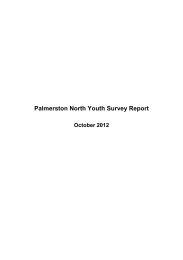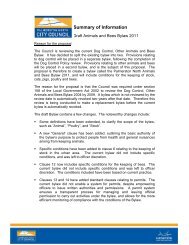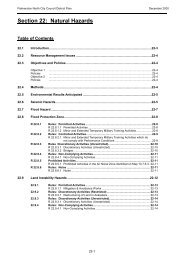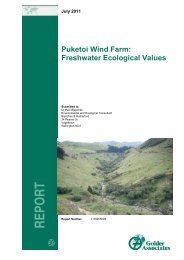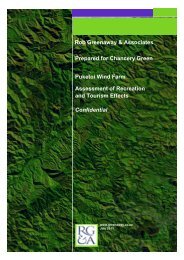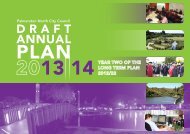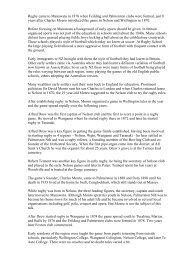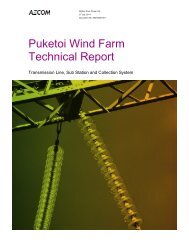Part 1 - Palmerston North City Council
Part 1 - Palmerston North City Council
Part 1 - Palmerston North City Council
Create successful ePaper yourself
Turn your PDF publications into a flip-book with our unique Google optimized e-Paper software.
gemconsulting<br />
The proposed works have been designed by the MWRC River Engineers. The design has been peer<br />
reviewed by Gary Williams from G & E Williams Consultants Ltd. The peer review is attached to this report<br />
as Appendix C.<br />
It is intended to complete the works over one summer period (preferably the summer of 2012/13).<br />
However it is recognised that this timeframe depends on weather conditions and river flows. If we have<br />
another wet summer the works may need to be put off until more favourable conditions exist. It is also<br />
possible that the works proposed by the applicant occur in one summer and the majority of the works<br />
proposed by PMB Landco Ltd occur the following summer.<br />
3.1 Reasons for the Proposed Works<br />
There are a number of reasons for carrying out the works in the river at the ANZAC Park Cliffs. As noted,<br />
the cliff has started to erode much faster than was anticipated, particularly since 2004, and it is estimated<br />
that some 20,000m 3 of soil is now being eroded from the cliff each year. The rate of erosion can be easily<br />
seen in the aerial photographs attached to this report as Appendix D. This erosion is a significant source of<br />
sediment that is released to the Manawatu River each year, thereby contributing to the rivers already high<br />
sediment loadings. Once the works are completed it is anticipated that the erosion and sedimentation from<br />
the cliff will cease.<br />
The retreating cliff is causing a change in the direction of the river flow to the extent that it will eventually<br />
start to erode the opposite river bank, threatening the stopbank protecting the city. Major and costly<br />
works will be required to protect the integrity of the stopbank to ensure that it continues to protect the city<br />
from floods in the future.<br />
If the cliff is left to erode it will eventually expose the existing residentially zoned land on top of the cliff to<br />
significant risk. At some point works similar to those currently proposed will become necessary. As the cliff<br />
erodes, increased costs can be expected due to the river channel alignment continuing to deteriorate<br />
making it more difficult to rectify. Also if the cliff advances too far towards any residential development it<br />
may not be possible to rectify without purchasing land and or dwellings to complete the works.<br />
There is a significant risk to public safety. The site is a popular recreation site with people using the river for<br />
swimming and kayaking. The cliff is extremely unstable and large slips can occur with little or no warning.<br />
People pursuing recreational activities in that stretch of the river are exposed to a high level of risk. In<br />
addition, risk is also present at the top of the cliff. As residential development continues in the vicinity<br />
people are attracted to the open rural landscape around the top of the cliff. While the cliff has been<br />
fenced, a recent visit to the site revealed that the cliff has now retreated beyond the fence and that it no<br />
longer offers any protection to the public.<br />
3.2 Description of Activities<br />
To achieve the realignment of the river in a way that is physically possible, and to avoid or minimise effects<br />
on the river, certain works will be required to occur in a certain order. The following describes the main<br />
components of the works that will need to be undertaken to achieve the river realignment. A construction<br />
methodology has been developed that describes the works, the sequencing of works and mitigation<br />
methods in further detail. The methodology is attached to this report as Appendix E.<br />
Access and Stockpile Areas<br />
Approximately 30,000 tonnes of rock will be used in the construction of the rock lining, bed armouring and<br />
snub groyne. A stockpile area (Stockpile Site 1) will need to be created on the grassed area between the<br />
river and the Esplanade Walkway to accommodate up to 5,000 tonne of rock at any one time. This<br />
immediate supply of rock is required so that there are no delays once construction of the lining is initiated<br />
and also to smooth out any minor supply delays from the quarry should they arise.<br />
Stockpile Site 1 will be accessed from an existing track leading from the end of Albert Street. Up to 300<br />
tonnes of rock will be transported to the site each day, equating to 15 truck and trailer loads per day. It will<br />
4



